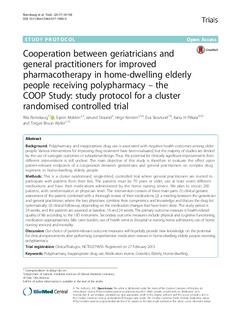| dc.description.abstract | Background
Polypharmacy and inappropriate drug use is associated with negative health outcomes among older people. Various interventions for improving drug treatment have been evaluated, but the majority of studies are limited by the use of surrogate outcomes or suboptimal design. Thus, the potential for clinically significant improvements from different interventions is still unclear. The main objective of this study is therefore to evaluate the effect upon patient-relevant endpoints of a cooperation between geriatricians and general practitioners on complex drug regimens in home-dwelling elderly people.
Methods
This is a cluster randomised, single-blind, controlled trial where general practitioners are invited to participate with patients from their lists. The patients must be 70 years or older, use at least seven different medications and have their medications administered by the home nursing service. We plan to recruit 200 patients, with randomisation at physician level. The intervention consists of three main parts: (1) clinical geriatric assessment of the patient, combined with a thorough review of their medications; (2) a meeting between the geriatrician and general practitioner, where the two physicians combine their competence and knowledge and discuss the drug list systematically; (3) clinical follow-up, depending on the medication changes that have been done. The study period is 24 weeks, and the patients are assessed at baseline, 16 and 24 weeks. The primary outcome measure is health-related quality of life according to the 15D instrument. Secondary outcome measures include physical and cognitive functioning, medication appropriateness, falls, carer burden, use of health services (hospital or nursing home admissions, use of home nursing services) and mortality.
Discussion
Our choice of patient-relevant outcome measures will hopefully provide new knowledge on the potential for clinical improvements after performing comprehensive medication reviews in home-dwelling elderly people receiving polypharmacy.
Trial registration
ClinicalTrials.gov, NCT02379455. Registered on 27 February 2015. | nb_NO |

